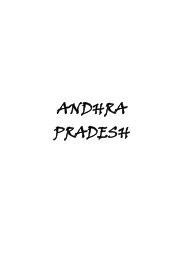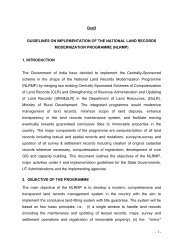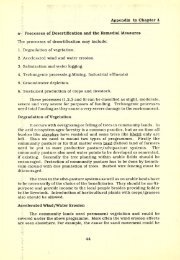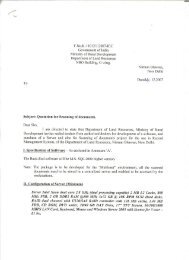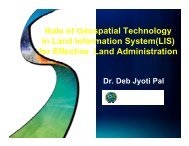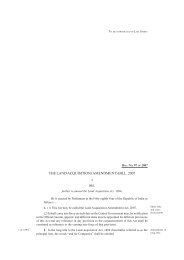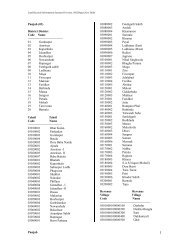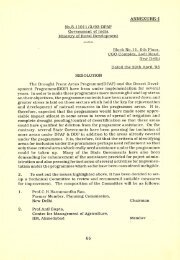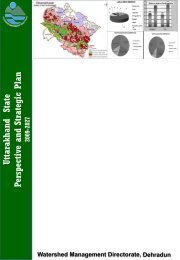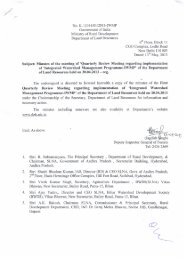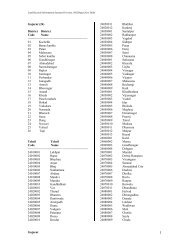Success Stories -NL -Final - Department of Land Resources
Success Stories -NL -Final - Department of Land Resources
Success Stories -NL -Final - Department of Land Resources
You also want an ePaper? Increase the reach of your titles
YUMPU automatically turns print PDFs into web optimized ePapers that Google loves.
H.4. A <strong>Success</strong>ful Venture through Watershed<br />
Programme<br />
A Case Study from Wokha, Nagaland<br />
IWDP Project-II in Wokha district <strong>of</strong> Nagaland covers 17 micro-watersheds which were<br />
scattered in all the five RD Blocks. A total <strong>of</strong> 17 villages with target area <strong>of</strong> 8300 Ha was<br />
covered. The conditions <strong>of</strong> the areas were pathetic, and with the lack <strong>of</strong> knowledge for<br />
resource utilization as well as minimum economic opportunities, it was evidently under<br />
poverty. There was large scale dependency on jhumming where 82% <strong>of</strong> the watershed<br />
community was engaged.<br />
PROBLEM STATEMENT<br />
With Jhum cultivation as the main livelihood activity, sustainable economic activity has slow<br />
progress. Due to excessive jhumming activity, there is rapid degradation <strong>of</strong> forest land, soil<br />
erosion and decreased water table. With the decreasing jhum cycle to 4-5 years which<br />
earlier was a cycle <strong>of</strong> 6-8 years, and increasing rural population leading to larger utilization <strong>of</strong><br />
jhum land, the once fertile land has been exhausted leading to result <strong>of</strong> low productivity <strong>of</strong><br />
jhum paddy and other agriculture products. This practice has also caused tremendous loss<br />
<strong>of</strong> both flora and fauna and habitat <strong>of</strong> many wild animals.<br />
Apart from this condition, it is faced with many problems, such as: lack <strong>of</strong> drinking water,<br />
lack <strong>of</strong> scientific method <strong>of</strong> farming, lack <strong>of</strong> accessibility to markets, there is a problem for<br />
various departments to undertake developmental activities due to lack <strong>of</strong> transport and<br />
communication.<br />
OBJECTIVES & METHODOLOGY<br />
With the above situation in mind, the project was implemented with the objectives <strong>of</strong><br />
optimum utilization <strong>of</strong> natural resources, employment generation through Income Generating<br />
Activities, to achieve sustainable productivity with the available resources, to improve overall<br />
condition <strong>of</strong> the watershed through plantation <strong>of</strong> various economic/commercial plants and<br />
crops viz. teak, gamari, hollock, orange, pineapple, rubber, areca nut, banana etc. to check<br />
degradation <strong>of</strong> land through construction <strong>of</strong> soil and moisture conservation structures such<br />
as Bench terraces, Water Harvesting Structures, Check Dams, etc. and,to promote scientific<br />
management and improvise the traditional methods <strong>of</strong> farming with active participation <strong>of</strong> the<br />
watershed community.<br />
IWDP intervention was targeted at the jhumming system for productive utilization <strong>of</strong> land. It<br />
was well accepted by the people as the activities were shaped to suit the local conditions<br />
that fitted easily into the jhum system.<br />
Activities taken up under IWDP Wokha-II project can be broadly classified into two general<br />
categories, namely production and treatment activities.<br />
Production activity consisted <strong>of</strong> afforestation, horticulture development and cash crops. Tree<br />
species <strong>of</strong> high commercial values such as, teak, gamari, hollock etc. were planted under<br />
afforestation. Major crops under horticulture & plantation crops consisted <strong>of</strong> oranges,<br />
pineapple, banana, arecanut, rubber plantation etc. Cash crops and medicinal & aromatic<br />
plants consisted <strong>of</strong> sugarcane, lemongrass, patchouli, agar etc. have been introduced to the<br />
project communities to fetch good economic return in short term.<br />
Treatment activity consisted <strong>of</strong> building bench terraces, contour bunds, check dams and<br />
water harvesting structures. Conservation structures have been built in the micro-watershed<br />
116




